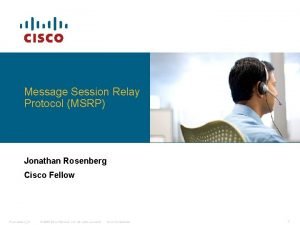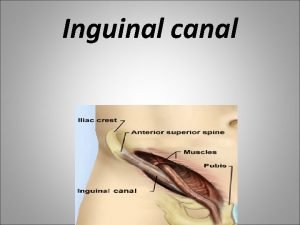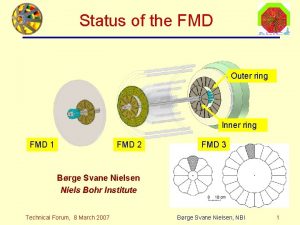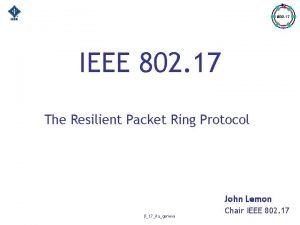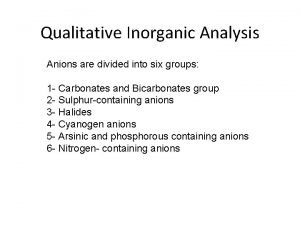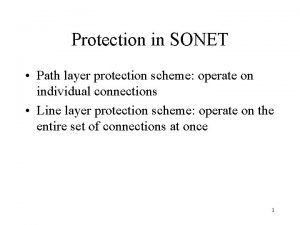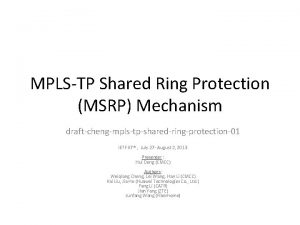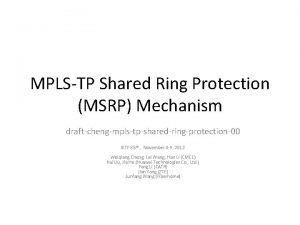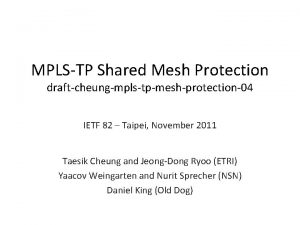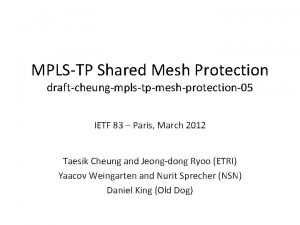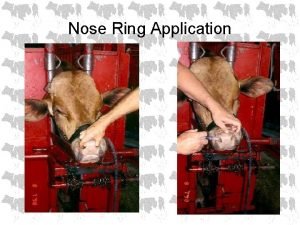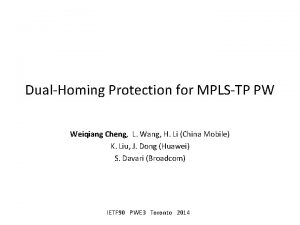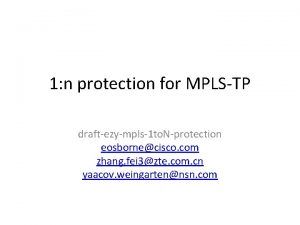MPLSTP Shared Ring Protection MSRP draftchengmplstpsharedringprotection04 Presenter Liang

















- Slides: 17

MPLS-TP Shared Ring Protection (MSRP) draft-cheng-mpls-tp-shared-ring-protection-04 Presenter: Liang Geng (CMCC) Authors: Weiqiang Cheng, L. Wang, H. Li (CMCC) Huub van Helvoort (Hai Gaoming BV) Kai Liu, Jie Dong, Jia He (Huawei) Fang Li (CATR) Jian Yang (ZTE) Junfang Wang (Fiberhome) IETF 92 MPLS Dallas 2015

Essentials of MSRP • Ring tunnel structure – Specify the data plane of ring tunnel • Ring protection mechanisms – Protection ring tunnels – Wrapping, short-wrapping, steering, interconnected ring • Section layer OAM – Minimize the number of OAM entities • Ring Protection Switching (RPS) protocol – Coordinate the protection operation

Ring Tunnels enter ring • Ring tunnels established based on exit nodes F • Shared by all services leaving the ring from the same node enter ring E • Labels of ring tunnel are provisioned via management plane, control plane is optional • Data plane of the working ring tunnels are D not closed ring leave ring • For each exit node, 2 pairs of ring tunnels are established for ring protection – clockwise working, protected by – anti-clockwise protection – anti-clockwise working, protected by – clockwise protection A B C clockwise and anti-clockwise working tunnels for node D

Why 4 Tunnels? enter ring F • Loop prevention 1. Traffic on clockwise working tunnel A E B D leave ring C

Why 4 Tunnels? enter ring F • Loop prevention E B X 1. Traffic on clockwise working tunnel 2. B switches traffic onto anticlockwise protection tunnel A D leave ring C

Why 4 Tunnels? enter ring F • Loop prevention discard traffic of protection tunnel EX B X X 1. Traffic on clockwise working tunnel 2. B switches traffic onto anticlockwise protection tunnel 3. E discards the traffic received on a protection tunnel A D leave ring C

Why 4 Tunnels? 5 G • Bandwidth management – Independent and clear bandwidth planning for working and protection F A 5 G 5 G E B 5 G 5 G D C 5 G

Ring Protection Mechanisms F • Wrapping – Protection tunnel needs to be a closed ring – Nodes adjacent to the failure execute traffic switching • B switches traffic to protection tunnel • C switches traffic back to working tunnel – Traffic detour on both sides • Not recommended enter ring A E B X D leave ring C

Ring Protection Mechanisms F • Short wrapping – Protection tunnel has same structure as working tunnel – Node first detecting the failure switches working tunnel traffic onto the protection tunnel – Traffic leaves the exit node without detouring to the downstream of the failure (C) enter ring A E B X D leave ring C

Ring Protection Mechanisms F • Steering – When ingress node is aware of the failure, it can switch traffic to the protection tunnel directly – Avoid traffic detour between ingress and the node detects the failure – Extra time for failure report propagation enter ring A failure report E B X D leave ring C

Section Layer OAM • Monitor the connectivity between each two adjacent nodes • Minimize the amount of OAM entities in ring topology – Compared with LSP level OAM F A E B D C section OAM

RPS Protocol • Failure detected by section OAM triggers ring protection switching protocol – Each node sends RPS messages periodically in both directions • RPS messages – A new G-ACH channel type • RPS state machine – Refer to the draft for more details F A E B D C RPS messages on ring

History of Document • -00, presented in IETF 85, Nov. 2012 • -01, adds short-wrapping, Jul. 2013 • -02, adds RPS protocol, presented in IETF 90, Jul. 2014 • -03, fixes some typos, Jul. 2014 • -04, presented in IETF 92, Mar. 2015

Changes in -04 • Re-organize statements for better readability • Editorial changes • Draft is getting stable, and this solution has been deployed in real networks

Laboratory Test Steps Fault scenarios Packet loss Packet rate (packets/s) Traffic Path Switching time (ms) Initial normal 0 100000 A-B-C-G-H-I (green line) N/A Step 1 F 1+F 2 2693 100000 A-B-A-F-E-D-C-G-H-I (red line) 26. 9 Step 2 F 1+F 2+F 3 4396 100000 A-F-E-D-C-G-H-I (blue line) 43. 9 Step 3 Restore F 3 6 100000 A-B-A-F-E-D-C-G-H-I 0. 06 Step 4 Restore F 2 7 100000 A-F-E-D-C-G-H-I 0. 07 Step 5 Restore F 1 0 100000 A-B-C-G-H-I 0 • Test results show that the switching time of the ring protection was less than 50 ms, and the restoring switch time was ignorable (less than 0. 1 ms).

Field trial Linear APS Ring protection Ring protectio n 1. Using ring protection to protect link and non interconnection node failure. 2. Using linear APS to protect interconnection node failure. Ring protectio n Configration Linear APS Ring protection cooperate with linear APS interconnection node Ring protection Ring protectio n Linear proetection OAM period 3. 3 ms APS holdoff time 0 100 ms item interconnection node Ring proetction Test result(200 Tunnel configuration) Interconnected Ring switching time 23 ms~37 ms ring protection cooperate with linear APS ring protection switching time: 26 ms~35 ms Linear APS switch time(interconnection node failure): 118~133 ms Step 1: establish runnel for each node using NMS. Upgrade from Step 2: Move all work tunnel to the ring. linear protection Step 3:Delete linear APS and protection tunnel. to ring protection If using Interconnected ring mechanism. Operation time : less then 10 min Interconnected Ring protection Using interconnected ring protection technique to protect all link and node failure

Next Steps • Solicit feedbacks from WG • Ready for WG adoption?
 Relay protocol
Relay protocol Msrp
Msrp Five c's of pricing
Five c's of pricing Constriction ring and retraction ring
Constriction ring and retraction ring Wise men gifts
Wise men gifts Oblique canal
Oblique canal Inner ring and outer ring
Inner ring and outer ring Ball valve mechanism in hernia
Ball valve mechanism in hernia Token ring and resilient packet ring
Token ring and resilient packet ring Anions
Anions Ring christmas bells ding dong
Ring christmas bells ding dong Ring protection scheme layers
Ring protection scheme layers How was ma liang like
How was ma liang like Yuanxing liang
Yuanxing liang Perbezaan salur darah arteri dan vena
Perbezaan salur darah arteri dan vena Chia liang cheng
Chia liang cheng Zong-liang yang
Zong-liang yang Cara mengindeks nama perusahaan pt
Cara mengindeks nama perusahaan pt
